This room contains exhibits that document the urban development of ancient Perusia.
Outside Porta Santa Susanna
The following exhibits (in showcases 1-3) come from what seems to have been an ancient settlement near the junction of what are now Viale Pellini and Piaggia Colombata (see Walk III).
Fragments from a Furnace (9th or 8th century BC)
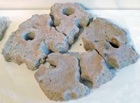
Amphora (ca. 700 BC)

Alfabetario di Perugia (late 6th century BC)
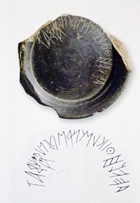
-
✴The main part of the inscription sets out the Etruscan alphabet, using 19 letters from the version of the Greek alphabet that was used in Corinth. This is in a form that is typical of those from Chamars (Chiusi) at this period.
-
✴The last four letters seem to have been added later: they are transcribed as “abat”, which might mean “alphabet” or perhaps “a, b” (as in the English expression “abc” for the alphabet).
This artefact is also described in the page on Early Etruscan Inscriptions.
Forum of Perusia
The artificial terrace that was at the heart of the Etruscan city (see Walk I) was excavated in 2003-7. Its supporting walls along Via delle Cantine and Via Maestà delle Volte were broadly contemporary with the Etruscan city walls, while the stretch under Palazzo dei Priori seems to date to the Roman period.
[Title]
The oldest finds from the excavations include:
-
✴four pieces of bucchero (black pottery, 6th century BC) that seems to have been ritually buried (in showcase 6);

-
✴clay and pottery fragments (5th century BC), some of which contain graffiti that testifies to the presence of Etruscan people here more than a century before the walls of Perusia were built (in showcase 3); and

-
✴antefixes (4th and 3rd centuries BC) that presumably came from a temple on the site (in showcase 4).
Antefixes (2nd and 1st century BC)
A number of architectural fragments that were found along the wall of Palazzo dei Canonici in Via delle Cantine seem to have come from another temple, the podium which was found on the north west corner of the terrace (under the apse of the present Duomo). These excavations can be visited from the Museo Capitolare. This must have been the most important monument in Perusia; it may have been the temple dedicated to Uni (Juno) that miraculously escaped destruction after the Perusine War (40 BC). The terracotta antefixes exhibited here include:
-
✴a head of Silenus (in showcase 4); and
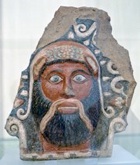
-
✴a figure (in showcase 5) that probably represented “Potnia Theron” (Artemis as Mistress of the Animals).
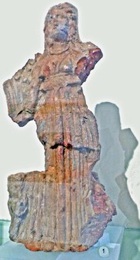
Remains from a domus (1st century BC)
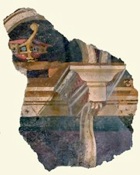
Piazza Cavallotti (3rd – 1st centuries BC)
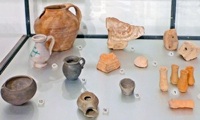
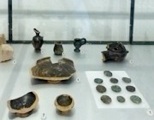
Showcase 8 includes a large number of objects that were found dumped in a ditch by the side of the road that was excavated in 1984 in the archeological area under Piazza Cavallotti. These included:
-
✴a number of asses (coins) from the late 3rd and early 2nd centuries BC (number 1);
-
✴a number of cult objects, including a fragment of an offering bowl (number 6), a small altar (number 11) and a votive breast (number 12) that probably came from a temple that was destroyed during the Perusine War (40 BC).
Quattuorviri (late 1st century BC)
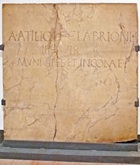
A. Atilio L. f. Glabrioni
IIIIvir(o)
municipes et incolae
To Aulus Atilius Glabrio, son of Lucius
Quattuorvir
[From the] citizens and inhabitants [of the municipium]
The museum has second inscription (CIL XI 1934) that commemorates a quattuorvir from the gens Atilia: it is on a cinerary urn that found in Perugia in the 16th century that is now in the deposit. This inscription attests the career of a man who (according to Simone Sisani, referenced below, at p. 276) was probably the son of Aulus Atilius Glabrio:
C. Atilius A. f. Glabrio
IIIIvir quinq(uennalis), praef(ectus) fabr(um)
delat(us) a co(n)s(ule), praef(ectus) cohor(tis)
Tyriorum sagittar(iorem)
Tettia A. f. Minore natus
Gaius Atilius Glabrio, son of Aulus and Tettia, had been Quattuorvir Quinquennales of the municipium (the magistrate responsible for the five-yearly census) and was also saw military service as a prefect in the Tyriorum Sagittariorum.
These inscriptions apparently both date to some time in the last two decades of the 1st century BC, and relate to the only quattuorviri known from inscriptions who held office after the destruction of Perugia by the future Emperor Augustus in 40 BC.
Via Thorrena Inscription (1st century AD)
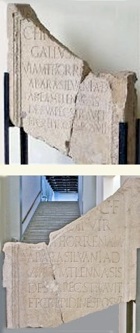
C[aius] Fir[mius] Gallus
[duo]vir, viam Thorrenam
ab ara Silvani ad
aream Tlennasis
de sua pec[unia] stravit
et crepidines posuit
This records that the duovir, Caius Firmius Gallus built and paved, at his own expense, a road called Via Thorrena:
-
✴from the altar of Silvanus, the Roman god of forests;
-
✴to the "area Tlennasis", which the museum suggests was an area sacred to an Etruscan god of the underworld that was perhaps located in a necropolis.
It is possible that the road that has been excavated in the archeological area under Piazza Cavallotti formed part of Via Thorrena. The fact that the inscription is double-sided meant that it could easily be read by people walking along the road in either direction.
Mosaic (6th century AD)

These fragments of a mosaic pavement (6th century AD) were discovered (along with traces of the walls of an ancient building) in the 1960s, during the adaptation of what was the Garage Gelsomini in Piazza Morlacchi (see Walk II) to house the Biblioteca Umanistica of the University of Perugia, and of its:
[More recent excavation has revealed part of a mosaic (6th century AD) that seems to have belonged to a church]
Leave the room by the opening on the right at the far end, into the parallel room,
which contains exhibits from Roman Umbria.
Return to the main page on the Museo Archeologico.



